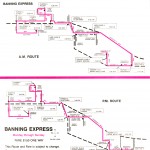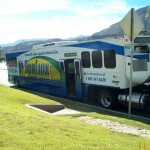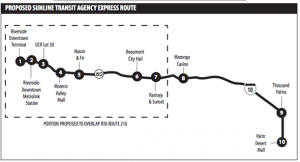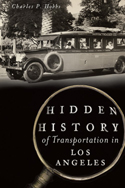In terms of bus service, Riverside County can be divided into three parts:
- Western Riverside County, from the border with San Bernardino and Orange Counties to the San Gorgonio Pass (Beaumont/Banning). This area includes the City of Riverside, which is the county seat.
- Coachella Valley, including Palm Springs, Desert Hot Springs, La Quinta, Indio, Coachella, etc.
- Palo Verde Valley: City of Blythe near the Arizona border.
Local bus service (Riverside Transit Agency, Sunline Transit, and Palo Verde Transit) within each of these areas developed in the mid-1970s. However, none of these agencies connected with each other. For example, to travel from Riverside to Palm Springs required the use of a private carrier (usually Greyhound Bus Lines).
Although Greyhound provided relatively frequent service, it was not always convenient for passengers making shorter trips, such as between Western Riverside County and the Coachella Valley. Therefore, the transit agencies considered implementing an interconnecting bus route between Riverside and Palm Springs as early as 1978. Such a route presents several challenges. The distance between the two cities is long, about 56 miles. Also, the route would go through areas that were (and, to some extent, still are), lightly populated, limiting opportunities to pick up passengers. Both these challenges make such a service expensive to operate.
The first attempt to link the two areas was in mid-1989. Sunline Transit started operating a new route #31, which provided a commuter service from Banning to the Coachella Valley. The bus left Banning at 6:13 a.m., arriving in the Coachella Valley at about 7. The return trip left about 4:45 pm, getting back to Banning by around 6 p.m Most of the Coachella Valley stops were at hotels; the service was obviously meant for hotel workers living in Banning to get to their jobs in the Coachella Valley. There was even a stop at a day care center in Banning so that parents could drop off their children before continuing on to the Coachella Valley. Route #31 lasted for about six months, then it was canceled by the end of the year. (I was only made aware of the route when, in March 1990, I was traveling through Banning and noticed a Sunline bus stop sign that had not been removed yet.)
In early 1992, RTA and Sunlink officials held a joint meeting in Banning. The purpose of the meeting was to determine ways in which the two agencies could work together. Most of the discussion centered around ideas such as using the other agency’s buses in an emergency, or perhaps joint purchases of buses, fuel or other equipment. However, I presented a plan to connect the two agencies with a bus route serving Riverside, Moreno Valley, Banning, Beaumont and Palm Springs. The general managers of both RTA and Sunline seemed genuinely interested in my proposal.
In mid 1995 or 1996, RTA extended a bus route, #35 between Moreno Valley and Beaumont. Many transit advocates (myself included) thought this route was a precursor to full Riverside-Palm Springs service.
Sunlink
By the late 1990s, discussion started up again about service between the Coachella Valley and Riverside. Sunline Transit decided to implement a new service, known as Sunlink, that would provide express service from points in the Coachella Valley to Downtown Riverside. The service, which featured tractor-trailer Superbuses, started in January 2000.
Originally, Sunlink was intended as an extension of Metrolink commuter rail service between Los Angeles and Riverside. The Superbuses, which were originally used on commuter routes between Los Angeles and Orange County, were equipped with a restroom, coffee machine, snack bar, and outlets for laptops.
Fares were considerably more expensive than local or even express bus service: $8 each way, or $12 for a round trip. (In a first for California, buses featured credit card readers for passenger convenience). The high fares, as well as the limited number of trips (generally about five or six round trips per weekday) kept ridership low. Sunline tweaked with the route and schedules, adding stops at the Morongo Casino, the outlet mall in Cabazon, and the V.A. Hospital in Loma Linda. But ridership stayed anemic and Sunline, concerned about high per-passenger subsidies on the route, canceled Sunlink in April 2004.
(Not?) the Return of Sunlink
After the death of Sunlink, those needing to travel between Riverside and Palm Springs were forced back on to Greyhound. But Greyhound had significantly cut back schedules over the past decade, and, even worse, lost its lease on its Palm Springs station in 2007. The replacement stop, the Amtrak station just south of Desert Hot Springs, is in an inconvenient location, and poorly served by local transit.
This time, Sunlink planned to cooperate with RTA. Two of RTA’s Commuterlink #210 runs between Banning and Riverside would be cancelled and replaced with Sunlink’s commuter route, which would at the Palm Desert Mall. From Banning westward, the Sunline bus would make all of the existing #210 stops. Fares would be reasonable; $3 (the current Commuterlink fare) from Palm Desert to Banning or from Banning to Riverside; the full trip would cost $6. Some potential riders have expressed concerns about the schedule and the lack of connections between the new commuter service and Sunline’s existing services (the commuter bus would leave Palm Desert before any Sunline locals could connect to it).
Public hearings and other preliminary tasks are currently underway at both RTA and Sunline; service could start in September 2012.
References:
1976 Riverside County Subregional Short Range Transit Plan. Riverside County: Planning Dept., 1976
Riverside County Short Range Transit Plan, 1979-1983. Riverside, CA: S.n., 1978.
“Commuter Bus Service to Begin Monday.: Desert Sun, Jan 29, 2000.
http://www.charlesphobbs.com/transit/sunlink.html (retrieved June 12, 2012)
Gabbard, Dana. “Sunline Trip Report.” Transit Advocate, March 2003.
Trone, Kimberly. “New Year Brings Revised Bus Schedule.” Desert Sun, Dec 20, 2003.
____, “Sunline Scraps Commutes Outside Valley.” Desert Sun, April 5, 2004.
Frith, Stephanie. “Greyhound’s gone, but what’s next?” Desert Sun, Jul 2, 2007
http://www.sunline.org/pub/agenda/2012/STA_Apr.pdf (page 23 of PDF)
http://www.sunline.org/pub/agenda/2012/STA_Apr.pdf (page 18 of PDF)
Atagi, Colin. “Palm Desert-Riverside bus route eyed by SunLine Transit Agency.“ Desert Sun, Apr 22, 2012.
_____. “SunLine Commuter Bus from Palm Desert to Riverside a possibility.” Desert Sun, May 30, 2012
_____. “Residents Discuss Commuter Bus Line to Riverside.” Desert Sun, Jun 7, 2012.




Recent Comments